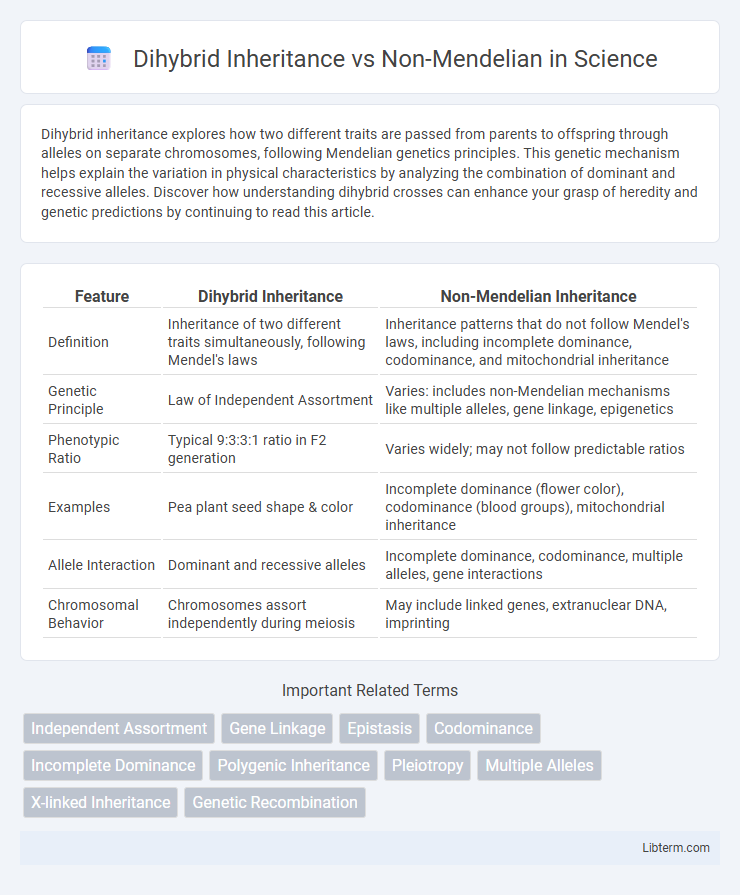Dihybrid inheritance explores how two different traits are passed from parents to offspring through alleles on separate chromosomes, following Mendelian genetics principles. This genetic mechanism helps explain the variation in physical characteristics by analyzing the combination of dominant and recessive alleles. Discover how understanding dihybrid crosses can enhance your grasp of heredity and genetic predictions by continuing to read this article.
Table of Comparison
| Feature | Dihybrid Inheritance | Non-Mendelian Inheritance |
|---|---|---|
| Definition | Inheritance of two different traits simultaneously, following Mendel's laws | Inheritance patterns that do not follow Mendel's laws, including incomplete dominance, codominance, and mitochondrial inheritance |
| Genetic Principle | Law of Independent Assortment | Varies: includes non-Mendelian mechanisms like multiple alleles, gene linkage, epigenetics |
| Phenotypic Ratio | Typical 9:3:3:1 ratio in F2 generation | Varies widely; may not follow predictable ratios |
| Examples | Pea plant seed shape & color | Incomplete dominance (flower color), codominance (blood groups), mitochondrial inheritance |
| Allele Interaction | Dominant and recessive alleles | Incomplete dominance, codominance, multiple alleles, gene interactions |
| Chromosomal Behavior | Chromosomes assort independently during meiosis | May include linked genes, extranuclear DNA, imprinting |
Introduction to Genetic Inheritance
Dihybrid inheritance involves the simultaneous inheritance of two different traits controlled by two gene pairs, following Mendel's laws of independent assortment and segregation. Non-Mendelian inheritance encompasses patterns such as incomplete dominance, codominance, mitochondrial inheritance, and polygenic traits that do not adhere to Mendelian ratios. Understanding these inheritance patterns is crucial for analyzing genetic variations and predicting phenotypic outcomes in organisms.
Defining Dihybrid Inheritance
Dihybrid inheritance refers to the genetic transmission involving two different traits, each controlled by different genes located on separate chromosomes, following Mendel's law of independent assortment. This type of inheritance predicts the distribution of combined phenotypes in offspring based on dominant and recessive allele interactions for both traits. Unlike non-Mendelian inheritance, which involves complex patterns such as incomplete dominance, codominance, or mitochondrial inheritance, dihybrid inheritance strictly adheres to classic Mendelian principles.
Mendelian Principles of Dihybrid Crosses
Dihybrid inheritance follows Mendelian principles, involving two genes with two alleles each, exhibiting independent assortment and segregation during gamete formation, resulting in a 9:3:3:1 phenotypic ratio in the F2 generation. Non-Mendelian inheritance deviates from these patterns, including phenomena like incomplete dominance, codominance, and gene linkage, where the classic Mendelian ratios are altered. Understanding the Mendelian foundation of dihybrid crosses helps differentiate these from complex inheritance patterns in non-Mendelian genetics.
Classic Dihybrid Ratio and Punnett Squares
Dihybrid inheritance involves the study of two traits simultaneously, typically exhibiting a classic 9:3:3:1 phenotypic ratio in the F2 generation, as predicted by Mendelian genetics using Punnett squares. Non-Mendelian inheritance deviates from these expected ratios due to phenomena like incomplete dominance, codominance, or gene linkage, which traditional Punnett squares cannot fully predict. Punnett squares remain essential tools for visualizing dihybrid crosses, enabling the determination of genotype combinations and expected phenotypic ratios under Mendelian principles.
Overview of Non-Mendelian Inheritance
Non-Mendelian inheritance encompasses genetic patterns that deviate from Mendel's laws, including incomplete dominance, codominance, multiple alleles, and polygenic traits. Unlike dihybrid inheritance, which involves the independent assortment of two gene pairs following Mendelian ratios, non-Mendelian inheritance demonstrates more complex interactions such as gene linkage, mitochondrial inheritance, and epigenetic modifications. These mechanisms contribute to phenotypic diversity that cannot be explained by simple dominant-recessive allele relationships.
Types of Non-Mendelian Inheritance Patterns
Dihybrid inheritance involves the simultaneous inheritance of two traits, typically following Mendel's laws of independent assortment and dominance. Non-Mendelian inheritance patterns include incomplete dominance, codominance, multiple alleles, polygenic inheritance, mitochondrial inheritance, and genomic imprinting, which deviate from classic Mendelian ratios. These patterns are crucial for understanding complex genetic phenomena such as variable expressivity, phenotypic diversity, and sex-linked traits.
Key Differences Between Dihybrid and Non-Mendelian Inheritance
Dihybrid inheritance involves the simultaneous inheritance of two different traits controlled by two genes located on different chromosomes, following Mendel's law of independent assortment. Non-Mendelian inheritance includes patterns such as incomplete dominance, codominance, mitochondrial inheritance, and polygenic traits, where inheritance does not follow classic Mendelian ratios. Key differences lie in predictable phenotypic ratios in dihybrid crosses versus variable or complex inheritance patterns in non-Mendelian cases due to gene interactions or external factors.
Real-World Examples: Dihybrid vs Non-Mendelian Traits
Dihybrid inheritance involves the study of two genes and their alleles, exemplified by Mendel's classic pea plant experiments where seed shape and color were inherited independently, following predictable 9:3:3:1 phenotypic ratios. Non-Mendelian traits, such as human blood groups (ABO system) and incomplete dominance in snapdragon flowers, do not follow Mendelian ratios due to co-dominance, multiple alleles, or gene interactions. Real-world examples highlight dihybrid inheritance's clear dominant and recessive allele patterns, while non-Mendelian traits demonstrate complex genetic mechanisms affecting phenotype expression.
Implications in Modern Genetics Research
Dihybrid inheritance, based on Mendelian principles, involves the independent assortment of two traits and provides a foundation for predicting genotype and phenotype ratios in offspring. Non-Mendelian inheritance encompasses complex patterns such as incomplete dominance, codominance, and epigenetic modifications, revealing the limitations of classic Mendelian genetics in explaining phenotypic variability. Modern genetics research leverages both dihybrid and non-Mendelian inheritance patterns to understand gene interactions, hereditary diseases, and the influence of environment on gene expression, advancing personalized medicine and genomic editing technologies.
Conclusion: Understanding Complex Genetic Patterns
Dihybrid inheritance exemplifies Mendelian genetics by illustrating the independent assortment of two gene pairs, resulting in predictable phenotypic ratios, such as the classic 9:3:3:1 ratio in Mendel's pea plant experiments. Non-Mendelian inheritance encompasses complex genetic patterns, including incomplete dominance, codominance, and polygenic traits, which demonstrate that gene interactions and environmental factors influence phenotypic expression beyond simple dominant-recessive relationships. Understanding these complex genetic patterns is crucial for advancing genetic research, enhancing disease prediction, and improving personalized medicine approaches.
Dihybrid Inheritance Infographic

 libterm.com
libterm.com